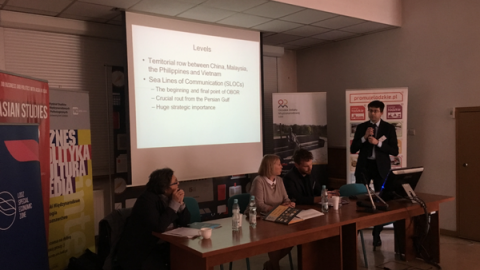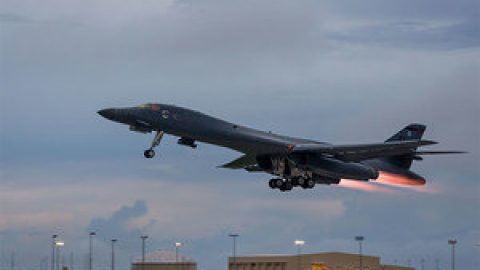2014-03-26
SEOUL/WASHINGTON, March 26 (Yonhap) — North Korea test-fired two ballistic missiles into the sea off its east coast Wednesday as the leaders of South Korea, the U.S. and Japan held a summit in the Netherlands to pressure Pyongyang to denuclearize. Seoul condemned the launch as a violation of U.N. Security Council resolutions and vowed to take countermeasures against the latest “provocations.”
North Korea fired the midrange missiles — one at 2:35 a.m. and the other at 2:42 a.m.– from the Sukchon region, north of Pyongyang, which flew about 650 kilometers before dropping into the East Sea, defense ministry spokesman Kim Min-seok said in an emergency briefing.
“North Korea’s ballistic missile launch clearly violates U.N. Security Resolutions and is a grave provocation to Republic of Korea (South) and the international community,” Kim said.
The trajectory indicated that the missiles were of the Rodong class, as they flew over at altitudes of more than 160 km and with a top speed of over Mach 7.0., the spokesman noted.
The foreign ministry said the South Korean “government will begin to take countermeasures against the North’s latest provocations through close collaboration with allies and the United Nations Security Council.”
The foreign ministry also denounced the ballistic missile launches as grave threats to international navigation activities and civilian safety, warning the North against further provocative actions.
“The missile launch constitutes provocations that violate the UNSC resolutions and add tensions on the Korean Peninsula and in the Northeast Asian region,” the ministry said in a statement. “The government calls on the North to immediately halt such provocations and fully comply with its obligations and promises with the international community.”
The North fired a Rodong missile in 2006, followed by another launch in 2009.
North Korea is prohibited from any launch using ballistic missile technology under U.N. Security Council resolutions that were imposed on the impoverished nation for its past nuclear tests and missile launches.
Kim said Pyongyang is believed to have launched the missiles in protest of international pressure for denuclearization during the Nuclear Security Summit in The Hague earlier this week and the ongoing joint military drills between Seoul and Washington, as well as to show off its ballistic missile capability.
“We strongly urge North Korea to stop repeated provocative acts immediately,” Kim said. “The South Korean and U.S. forces have stepped up their vigilance to monitor possibilities of additional launches.”
The latest launch came hours after the leaders of South Korea, the U.S. and Japan held a trilateral summit in The Hague on the sidelines of the global nuclear forum to seek expanded cooperation to denuclearize North Korea.
In a joint press conference after the trilateral summit, South Korean President Park Geun-hye called for a unified response to the North Korean nuclear problem, while U.S. President Barack Obama said a nuclear North Korea is unacceptable.
The launch also took place on the same day South Korea commemorates the fourth anniversary of the sinking of the Cheonan warship, which was hit by a North Korean torpedo in the tensely guarded western sea. Pyongyang still denies its involvement in the incident that killed 46 sailors.
The communist state has fired off several short-range missiles and rockets from its east coast since late February, drawing sharp criticism from both Seoul and Washington.
Compared with short-range Scud missiles the North fired earlier this month, Rodong missiles, which have an estimated range 1,000 km to 1,500 km, are considered to be more destructive as they can carry a nuclear warhead, only if Pyongyang is capable of developing a small enough warhead to fit on them.
“Japan, some parts of China and Russia are within the range of Rodong missiles,” Kim said. “The North’s pre-dawn missile launch is believed to be aimed at protesting against South Korea-U.S. joint military exercises and demonstrating its infiltration capability in a show of force.”
The two-week war game Key Resolve ended in early March, while the two-month combat training Foal Eagle runs through April 18.
The missiles, which were fired without a preannouncement, fell within 10 km of Japan’s air defense identification zone, a senior military official said, citing analysis of their trajectory.
“Although there were no airplanes flying near the trajectory of the missiles before and after the launch, launching missiles without declaring a no-fly, no-sail zone is a violation of the international regulations,” the official said on the condition of anonymity.
When Pyongyang fired several Scud short-range missiles on March 3 from its east coast, they landed within Japan’s air defense zone.
Beijing also expressed concerns after it was discovered that a Chinese airline flew through the same airspace as one of the artillery fired on March 4 from the North’s east coast.
According to military intelligence, the missiles were fired from a mobile launcher called TEL (transporter, erector, launcher), which is hard to detect using military satellites or the ground radar system.
The North is believed to have about 40 TELs for Scud missiles, 40 TELs for Rodong missiles and 14 TELs for Musudan missiles with ranges of 2,500 km to 4,000 km. The North first deployed Rodong-class missiles in 1997.
The U.S. military, however, evaluated that the North has up to 200 mobile launchers for ballistic missiles, more than double Seoul’s assessment.
In Washington, the U.S. Department of Defense said it is aware of “reports that North Korea fired a number of missiles.”
“We are closely monitoring the situation on the Korean Peninsula,” a Pentagon official said in an e-mail, saying it’s the department’s formal position on the issue. “We continue to urge North Korea to exercise restraint and take steps to improve its relations with its neighbors. The onus is on North Korea to refrain from provocations.”
The U.S. State Department said it is considering taking “appropriate” measures in response to North Korea’s firing of two midrange ballistic missiles.
ejkim@yna.co.kr
lcd@yna.co.kr
leechidong@gmail.com
source : Yonhap News
http://english.yonhapnews.co.kr/search1/2603000000.html?cid=AEN20140326000554315



